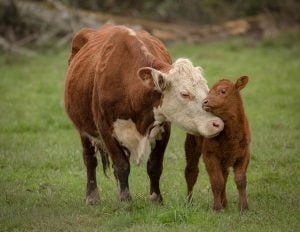The choices that livestock producers make in their day-to-day practices impact all corners of their operations, including herd health. Factors such as herd genetics and quality of feed have an effect on end results for both the individual animal and the producer, but can they work together to provide positive outcomes for both?
For the moment, let’s focus on only the animal’s well-being. Real-time choices concerning livestock could be thought of as chain links that, when combined, can assist in improving individual animal health.
Calf weaning practices and systems are a specific example of this. Each possible choice offers various pros and cons that may fit a producer’s desire but have differing effects on the individual animal. No strategy is right or wrong in and of itself but can only be beneficial to the calves if supported by the correct management practices.
Existing producers have fundamental limitations, be it land, pasture, finances, feed availabilities, or other roadblocks, but they also have unfettered information, data, and options available, literally at their fingertips. Constantly completing tasks in the same way may be easier and more convenient but might not provide the best results for the health of the animal.
Control the stress link at weaning
At its core, good health is about controlling and limiting stress. This heavyweight chain will subsequently produce good health if composed of management practice links working together in the best interest of the animal. It is not enough to choose a weaning strategy without installing the proper infrastructure, fencing, vaccinations, experienced manpower, knowledgeable pen riders and barn workers, quality feed, and veterinarian-based expertise, among countless other links. Each must be reinforced and supportive of their neighbors, or the result of optimum animal health will never be reached.

Abrupt from cow to auction weaning
Examining specific weaning practices, abrupt from the cow to the auction barn is the simplest but also the vaguest. Health results of these calves are often an unknown as systems of weaning are not widely tracked to provide health data, other than through occasional research trials. But without large amounts of specific data, there are some known negatives and positives of the approach.
A report by the Beef Checkoff in Centennial, Colorado, showed a myriad of factors negatively impacting weaned calves regarding trucking and shrinkage when weaning directly to auction. They found that transportation pressures coupled with the co-mingling of cattle can greatly increase stress, shrinkage and the incidence of respiratory diseases plus high ambient temperature and rough handling of cattle can add to this shrink through potential tissue loss, potentially exceeding 60 percent of total body weight in extreme cases.
But unless a producer plans to finish their own calves at the site of origin, these stresses will always be a link in the chain, only the timing will be manipulated.
Truck to auction weaning may seem harsh, but Craig Rozenboom, owner of the Knoxville Livestock Auction in Iowa, states that feedlots prefer green or longer-term preconditioned calves, specifically from a “health of the calf” view. “Everyone likes to see either a 45-day weaning or completely green calves from a health side. That’s the way we like to see them handled. We recognize that a lot.”
Pasture or fence-line weaning
In 2006 and 2007 calf trials, New Mexico State University attempted to prove that fence-line and pasture weaning of calves left in familiar surroundings was less stressful for the animals. They concluded that calves weaned in this manner showed increases in weight gain after two weeks (16 and 4 pounds respectively), had decreased vocalizations and spent less time walking. In their view, these actual demonstrations of good health proved a reduction of stress.
Dr. Derek Haley, Associate Professor at the Ontario Veterinary College, University of Guelph, agreed with these findings. He conducted his own research into fence-line weaning with cows and calves separated by a secure fence allowing the calves to see, hear, and sense their mother’s presence while not being able to suckle. He concluded these calves vocalized 50 percent less, walked less, and had higher weight gains in the first 10 weeks after separation than abruptly weaned calves.
This can be a calf-friendly system although also very dependent on the infrastructure link of a costly fence and a handling system or work process to treat ill animals in the open.
Dry-lot and preconditioned weaning
A dry-lot system with or without a preconditioning program provides a variety of chain links and options but is also more heavily dependent on work processes and resources. An illness period can strike no matter how well calves are treated, but established preconditioning programs such as VAC-45 developed by Texas A&M University indicate over long-term trials that calves enrolled in the planned vaccination and days of weaning program have only one third as many sick and less than half the dead calves.
Proactive links in this chain include vaccination protocols that allow the necessary time for a calf to raise their level of resistance to viral and bacterial pathogens before being challenged by disease.
Glenn Selk, an Oklahoma State University Extension Animal Scientist, shows support for longer term weaning when describing a nine-year Iowa trial with data from over 2,000 calves. It concluded that those weaned for less than 30 days had a 28 percent higher incidence of bovine respiratory disease compared to calves weaned longer than 30 days.
Management practices in support of weaning
No matter the method used to wean calves, management practices and work process links must be supported to ensure the strength of the desired “health of the calf” chain. And although this is a normal thought process to a majority of cow/calf producers, sometimes surprisingly for the uninformed looking in on the cattle industry, the links that combine to solidify the health of the calf as a priority are the same links that support productivity, efficiency, weight gain, feed conversion, and carcass value and grade. What is good for the animal is always good for the conscientious producer.
Bruce Derksen has worked in Western Canada’s ranching and feedlot industry for over 30 years. He writes about present-day agriculture, hoping to give producers as much up-to-date information and insights about the future of the industry as possible.



